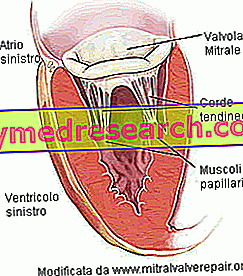Generality
Mitral insufficiency (or mitral regurgitation ) consists of the incomplete closure of the left atrioventricular orifice, in which the mitral valve (or mitral valve) resides; this happens during the phase of ventricular systole, that is, in the moment of contraction of the ventricles of the heart; under similar conditions, finding the orifice not completely closed due to valvular incontinence, the blood returns partially backwards, passing from the left ventricle to the left atrium: it is the so-called mitral regurgitation.
The causes of mitral insufficiency are numerous and such as to cause injury in one or more components of the mitral valve. The symptoms, although less obvious, are very similar to those of mitral stenosis: dyspnea, atrial fibrillation and weakness, to name a few.
To diagnose mitral insufficiency, various instrumental methods are used: electrocardiography, echocardiography, chest X-ray and cardiac catheterization each have different advantages in assessing the extent of heart disease. Treatment depends on the severity of mitral failure: if the situation is critical, surgery is required.
What is mitral insufficiency
Pathological anatomy and pathophysiology
Mitral insufficiency, also called mitral regurgitation, consists of the incomplete closure of the left atrioventricular orifice, presided over by the mitral valve (or mitral valve).
Under normal conditions, during the ventricular systole (when the ventricle contracts), the mitral valve hermetically closes the passage between the atrium and the ventricle; consequently the blood flow takes only one direction, towards the aorta.
In the presence of mitral insufficiency, the pathological event occurs precisely during the phase of ventricular systole: when the ventricle contracts, a share of blood, instead of turning into the aorta, turns back and goes back to the upper left atrium. For this reason, mitral insufficiency is also called mitral regurgitation.
Before examining how a mitral valve looks and works in cases of mitral insufficiency (analyzing pathological anatomy and physiopathology, respectively), it is useful to mention some fundamental characteristics of the valve:
- The valve ring . Circumferential structure of connective tissue defining the valve orifice.
- The valve orifice measures 30 mm in diameter and has a surface of 4 cm2.
- Two flaps, front and back. It is said, for this reason, that the mitral valve is bicuspid . Both flaps fit into the valve ring and look towards the ventricular cavity. The anterior leaflet looks towards the aortic orifice; the posterior flap faces, instead, on the wall of the left ventricle. The flaps are composed of connective tissue, rich in elastic fibers and collagen. To facilitate the closure of the orifice, the edges of the flaps have particular anatomical structures, called commissures. There are no direct controls, of the nervous or muscular type, on the flaps. Similarly, there is no vascularization.
- The papillary muscles . They are two and are extensions of the ventricular musculature. They are sprayed by the coronary arteries and give stability to the tendinous cords.

In the presence of a mitral insufficiency, based on the triggering cause, injuries are created to one or more of these valve components. Based on the effects induced by each cause, two types of mitral insufficiency were distinguished, each grouping different physiopathological behaviors. Therefore, we have:
- Acute mitral valve insufficiency.
- Chronic mitral insufficiency.
The difference between the acute and the chronic form depends, first of all, on the rapidity with which the cardiopathy itself is established. Before going into this point, however, we need to clarify some physiopathological aspects common to both forms.
In the case of mitral insufficiency, both the left atrium and the left ventricle affect the pathological adaptation of the blood flow. Under normal conditions, during ventricular systole, the hermetic closure of the mitral ensures the unidirectionality of the blood flow towards the aorta. In the presence of mitral insufficiency, however, the left ventricle pumps blood in two directions: aorta (correct direction) and left atrium (wrong direction due to valvular incontinence). Therefore, the proportion of blood reaching the tissues is reduced and its flow rate varies according to the size of the orifice: the less efficient the mitral closure, the greater the amount of blood returning to the atrium (regurgitated fraction) and the cardiac output is lower. Furthermore, the left atrium dilates accordingly to accommodate the greatest amounts of blood.
During diastole, that is, in the relaxation phase of ventricles and atria, the regurgitated blood (in the atrium) returns to the ventricle, as the mitral valve opens in this phase.
This last abnormal blood movement and the previous regurgitation have effects on the atrioventricular pressure gradient . Gradient means a variation, in this case of pressure. In fact, in the presence of a mitral stenosis the pressure ratio, existing between the two compartments, varies from normal. The pressure changes are due to the proportion of regurgitated blood, which, stopping first in the atrium and then in the ventricle, is added to that coming from normal circulation. This occurs at the wrong times and all results in an increase in ventricular pressure. In this case we speak of left ventricular failure .
If the cause of mitral insufficiency slowly determines this scenario just described, the left ventricle is able to adapt to the changes ( chronic form ): it becomes hypertrophic, in such a way as to keep the pressure increase within it under control. In fact, the hypertrophic ventricular walls, at the time of contraction, counterbalance the considerable tension caused by the high pressure and the regurgitated altitude remains stable. This situation, however, creates a slow deterioration of the ventricular walls, destined to lead to a decrease in cardiac output.
If the cause of mitral insufficiency, on the other hand, develops the physiopathological mechanisms described above rapidly, the left ventricle does not have sufficient time to adapt to the change and does not become hypertrophic ( acute form ). The walls of the ventricle are therefore unable to withstand the tension due to the high pressure and the extent of blood regurgitation increases progressively. This causes a continuous rise in pressure inside the left atrium, such as to affect the vessels and districts located upstream, the pulmonary veins and the lungs, with possible development of edema.
Causes
The causes of mitral insufficiency are numerous. Each of them causes lesions of one or more structural elements that make up the mitral valve; sometimes, it can happen that two different causes, adding together, give a lesion of only one valve component.
In the case of acute mitral insufficiency:
| Type of injury | Cause |
Alterations of the mitral ring Alterations of the valve leaflets Rupture of the tendinous cords Papillary muscle disorders | Infective endocarditis; trauma; acute rheumatic disease; idiopathic; myxomatosis degeneration (collagenopathy); coronary artery disease; malfunction of the valve prosthesis. |
In the case of chronic mitral insufficiency:
| Type of injury | Cause |
Alterations of the mitral ring Alterations of the valve leaflets Rupture of the tendinous cords Papillary muscle disorders | Inflammatory; rheumatic heart disease; calcification; myxomatosis degeneration (collagenopathy); infective endocarditis; cardiac ischemia; Marfan syndrome (congenital); valvular cracking (congenital); mitral valve prolapse (congenital); connective tissue. |
The two forms of mitral insufficiency, therefore, share only some causes.
Symptoms and signs
The main symptomatology of mitral insufficiency, although less obvious, has many similarities with that which characterizes mitral stenosis.
- Dyspnea on exertion.
- Cardiopalmus (palpitation).
- Respiratory infections.
- Asthenia.
- Chest pain due to angina pectoris.
- Pulmonary edema.
Effortless dyspnea consists of difficult breathing. In the specific case, it arises from the decreased cardiac output of the left ventricle, due to the proportion of blood regurgitated towards the atrium. Therefore, the organism's response consists in increasing the number of breaths, in order to counterbalance the reduced supply of oxygen due to the insufficient volume of the range.
Pulmonary edema is a typical symptom of acute mitral valve insufficiency. The rapid onset of heart disease does not allow the ventricle to limit the effects induced by increased ventricular pressure. Unlike what happens in the forms of chronic insufficiency, the left ventricle, in fact, does not have the time to become hypertrophic. As a result the proportion of regurgitated blood increases progressively. This results in a rise in pressure, not only in the left atrium, but also in the vessels and districts located upstream, ie pulmonary veins and lungs . The increased pulmonary pressure (pulmonary hypertension ) causes a compression of the respiratory tract and, in the most serious cases, the leakage of liquids from the vessels to the alveoli. This last condition is the prelude to pulmonary edema: in these conditions, the oxygen-carbon dioxide exchange between alveoli and blood is compromised.
Heart disease, also known as palpitation, is the most frequent symptom of mitral insufficiency. It consists of an increase in the intensity and frequency of the heartbeat. In the specific case, heart failure can result from atrial fibrillation
Atrial fibrillation is a cardiac arrhythmia, ie an alteration of the normal heartbeat rhythm. It is due to a disorder of the nerve impulse coming from the atrial sinus node. It results in fragmentary and ineffective atrial contractions from a haemodynamic point of view (ie what concerns the blood flow).
In the case of mitral insufficiency, the regurgitation of blood in the atrium alters the blood volume pushed into the aorta by ventricular contraction. In light of this, the body's oxygen demands are no longer satisfied. Faced with this situation, the individual, suffering from atrial fibrillation, increases respiratory acts, manifest palpitation, irregularity of the wrist and, in some cases, fainting due to lack of air. The picture can further degenerate: an ever increasing regurgitation and the accumulation of blood in the vascular systems upstream of the left atrium, if associated with an altered coagulation, give rise to the formation of thrombi (solid, non-mobile masses, composed of platelets) inside the vessels. The thrombi can disintegrate and release particles, called emboli, which, traveling in the vessel system, can reach the brain, or the heart. In these locations, they become an obstacle to normal spraying and oxygenation of brain or cardiac tissues, causing the so-called ischemic stroke (cerebral or cardiac) situation. In the case of the heart, one also speaks of a heart attack .
Unlike what happens for mitral stenosis, embolisms due to mitral insufficiency are more rare.
Respiratory or thoracic infections are due to pulmonary edema.
Chest pain, due to angina pectoris, is a rare event. Angina pectoris is due to left ventricular hypertrophy, ie the left ventricle. In fact, the hypertrophic myocardium needs more oxygen, but this request is not adequately supported by the coronary implant. It is therefore not the consequence of an obstruction of the coronary vessels, but of an imbalance between consumption and the supply of oxygen to the tissues.
The characteristic clinical sign of mitral insufficiency is the systolic murmur . It originates from the regurgitation of blood, through the half-open valve, during ventricular systolic contraction.
Diagnosis
Mitral insufficiency can be detected by the following diagnostic tests:
- Stethoscopy.
- Electrocardiogram (ECG).
- Echocardiography.
- Thoracic radiography.
- Cardiac catheterization.
Stetoscopy . Detection of a systolic murmur is the most useful indication for diagnosing an insufficiency of the mitral valve. The sound of the breath is produced by the passage, from the left ventricle to the left atrium, of the regurgitation of blood. It is perceived in the systolic phase, since it is at this moment that the mitral valve is not closed as it should. A strong breath is indicative of moderate insufficiency, but not necessarily a strong one. In fact, a weak breath is perceived both in individuals with mild mitral insufficiency and in subjects with severe (ie severe) insufficiency. This last situation is the consequence of a progressive degeneration of the left ventricle. The detection zone is in the V intercostal space, ie the one coinciding with the position of the mitral valve.
ECG . By measuring the electrical activity of a heart with mitral insufficiency, the ECG shows:
- Hypertrophy of the left ventricle.
- Overload of the left atrium.
- Atrial fibrillation.
- Cardiac ischemia.
Diagnosis by ECG gives an idea of the degree of severity of mitral failure: if the outcome is comparable to that of a healthy individual, it means that it is not a severe form; vice versa, the examination shows the mentioned irregularities.
Echocardiography . Taking advantage of the ultrasound emission, this diagnostic tool shows, in a non-invasive way, the fundamental elements of the heart: atriums, ventricles, valves and surrounding structures. From echocardiography, the doctor can detect:
- Abnormal behavior of the flaps due to damage to the tendon strings of the valve.
- Anomalies of the left ventricle, during the phases of systole and diastole.
- Increase in the size of the left atrium (dilated atrium).
- The maximum flow velocity is the turbulent systolic flow of the regurgitation, employing continuous and pulsed Doppler techniques, respectively. From the first measurement, the pressure gradient between the left atrium and the left ventricle can be derived; from the second, the extent of regurgitation.
Chest x-ray . It is useful for observing the situation at the level of the lungs, verifying whether or not edemas are present. Moreover, it allows to see typical anatomo-pathological changes:
- Left atrium dilated by regurgitation of blood.
- Hypertrophic left ventricle.
- Calcification, determined by particular causes, of the valve or ring.
Cardiac catheterization . It is an invasive hemodynamic technique. A catheter is introduced into the vessel system and is led to the heart. Within the vascular and cardiac cavities, it acts as an investigating probe. The purposes of this exam are as follows:
- Confirm the clinical diagnosis.
- Evaluate the haemodynamic changes, ie the blood flow in vessels and cardiac cavities, in quantitative terms. In particular, the condition is explored at the lung level.
- Define confidently if you can intervene surgically.
- Evaluate the possible presence of other valve dysfunctions.
Therapy
The therapeutic approach varies according to the severity of mitral insufficiency. The mild, asymptomatic forms require preventive measures to prevent bacterial infections, such as endocarditis, which affect the heart cavities.
The first appearance of symptoms and moderate / severe forms require more attention, through drug therapy and, possibly, surgery.
The most used drugs, in the symptomatic cases of mitral insufficiency, are:
- ACE inhibitors . They are inhibitors of the enzyme system that converts angiotensin. They are hypotensive drugs, which reduce the increased pressure inside the left atrioventricular cavities and vascular systems residing upstream.
- Diuretics . They are also hypotensive.
- Vasodilators . Example: nitroprusside.
- Digital . It is used for atrial fibrillation.
Surgery becomes essential in some critical situations: when the patient has a severe form of chronic mitral insufficiency, or when he is afflicted with an acute form.
There are two possible surgical operations:
- Replacement of the valve with a prosthesis . It is the most implemented intervention for the valves of those individuals, not young, with serious anatomical anomalies. A thoracotomy is performed and the patient is placed in extracorporeal circulation (CEC). Extracorporeal circulation is achieved through a biomedical device which consists of creating a cardio-pulmonary pathway that replaces the natural one. In this way, the patient is guaranteed an artificial and temporary blood circulation that allows surgeons to interrupt the flow of blood in the heart, diverting it to another equally effective path; at the same time, it allows you to operate freely on the valve apparatus. Prostheses can be mechanical or biological. Mechanical prostheses require, in parallel, anticoagulant drug therapy. Biological prostheses last 10-15 years.
- Mitral valve repair . It is an approach indicated for mitral insufficiencies due to changes in the valve structures: ring, cuspids, tendinous cords and papillary muscles. The surgeon acts differently, depending on where the valve lesion resides. Again, patients are placed in extracorporeal circulation. It is an advantageous technique, as the prostheses have some drawbacks: as we have seen, the biological ones must be replaced after about 10-15 years, while the mechanical ones require the continuous administration, in parallel, of anticoagulants. It is a method that is not suitable for the rheumatic forms of mitral insufficiency: these, however, are rare.




